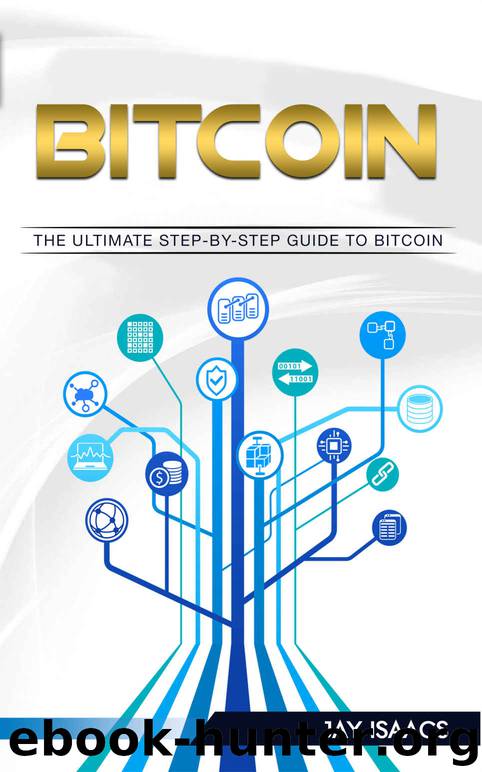Bitcoin: A Step-by-Step guide on mastering bitcoin and cryptocurrencies (blockchain, fintech, currency, smart contracts, money, understanding, ethereum, digital, financial, ledger, mining, trading) by Jay Isaacs

Author:Jay Isaacs
Language: eng
Format: azw3, epub
Published: 2017-09-06T07:00:00+00:00
What Is Blockchain?
In fact, blockchain is far more complex than this. As the name suggests, the blocks of information it holds are connected, or chained together. It is the technology on which cryptocurrencies operate, including bitcoin.
But as a facility, it has many more uses, and its functionality is very much in the early days of discovery.
So, it could be used to hold central registers of pretty much anything – votes cast in an election? Planning permission applications? Any kind of transactions? The list is endless.
It works by offering a network of computers to the chance to hold, simultaneously, a ledger, or book of information, that is spread throughout the entire network. Hence, this is called a distributed ledger. The ledger is also public, creating the term ‘public ledger’.
Decentralisation
Blockchain is a decentralised technology. This means that there is no one ‘holding’ base. If we use the example of a spreadsheet given above, and imagine it as a ledger of sales records, normally such a system will operate in the following way.
The head office will hold a central record. On it might be a list of the names of the sales staff at the company, then rows, perhaps showing weekly amounts sold, spreads out so that it is possible to track the sales of an individual sales person, or perhaps a group.
This spreadsheet might then be sent to the area offices, and managers there might use that data to share with others and use as, for example, the basis of a ‘sales person of the month’ award. At the end of the week, the sales staff will contact their area office to update their figures, these will be shared with the head office, who will update the spreadsheet and start the process again.
Although it can be difficult to get our heads around, the decentralised system of blockchain cuts out the different steps.
Here, every person associated with the company has a live version of the spreadsheet. After every individual sale, the sheet is updated instantly (or pretty much so) on each person’s computer.
Some Advantages Of Decentralisation
Such a system offers a range of advantages. It is incredibly fast. We can examine this by linking it to money and take an example still in use today, a main form of exchange until very recently. If somebody wished to buy something, they would often choose to pay by check.
The buyer would need some form of guarantee on the check, and the seller might have to wait three of four days to actually receive the money. A third party, the bank, would process the exchange of money. With bitcoin, because it uses blockchain technology, the currency leaves the buyer’s wallet and appears simultaneously in the wallet of the seller.
The system is also secure. For somebody to hack they need to hack every person on the network’s computer simultaneously. This is, as we see it at present, effectively impossible. The fact that it is not run by a single being or body adds to the security, since a solo operator is much more vulnerable to attack than a large group.
Download
Bitcoin: A Step-by-Step guide on mastering bitcoin and cryptocurrencies (blockchain, fintech, currency, smart contracts, money, understanding, ethereum, digital, financial, ledger, mining, trading) by Jay Isaacs.epub
This site does not store any files on its server. We only index and link to content provided by other sites. Please contact the content providers to delete copyright contents if any and email us, we'll remove relevant links or contents immediately.
International Integration of the Brazilian Economy by Elias C. Grivoyannis(84002)
The Radium Girls by Kate Moore(11832)
Turbulence by E. J. Noyes(7865)
Nudge - Improving Decisions about Health, Wealth, and Happiness by Thaler Sunstein(7427)
The Black Swan by Nassim Nicholas Taleb(6913)
Rich Dad Poor Dad by Robert T. Kiyosaki(6290)
Pioneering Portfolio Management by David F. Swensen(6150)
Man-made Catastrophes and Risk Information Concealment by Dmitry Chernov & Didier Sornette(5844)
Zero to One by Peter Thiel(5606)
Secrecy World by Jake Bernstein(4568)
Millionaire: The Philanderer, Gambler, and Duelist Who Invented Modern Finance by Janet Gleeson(4262)
Skin in the Game by Nassim Nicholas Taleb(4102)
The Age of Surveillance Capitalism by Shoshana Zuboff(4098)
The Money Culture by Michael Lewis(3993)
Bullshit Jobs by David Graeber(3964)
Skin in the Game: Hidden Asymmetries in Daily Life by Nassim Nicholas Taleb(3849)
The Dhandho Investor by Mohnish Pabrai(3618)
The Wisdom of Finance by Mihir Desai(3584)
Blockchain Basics by Daniel Drescher(3407)
